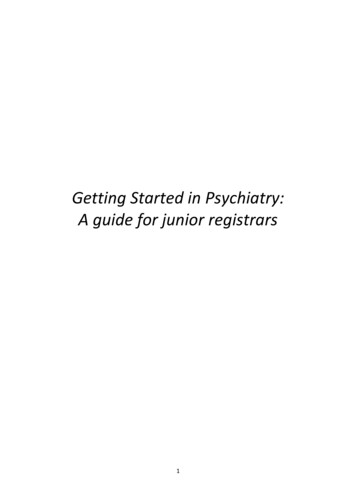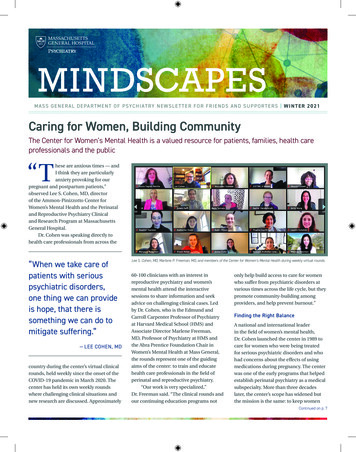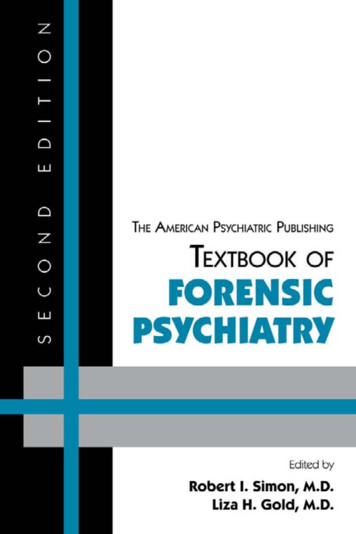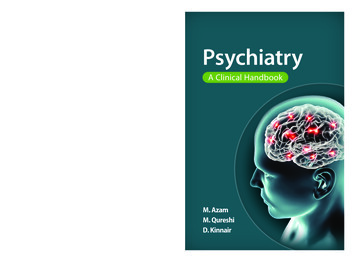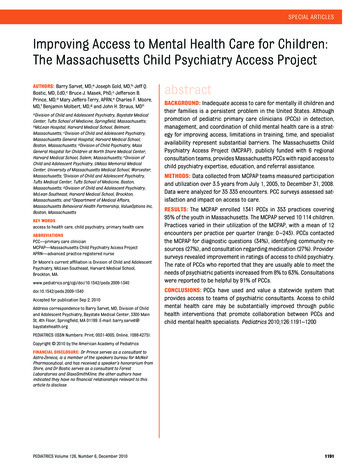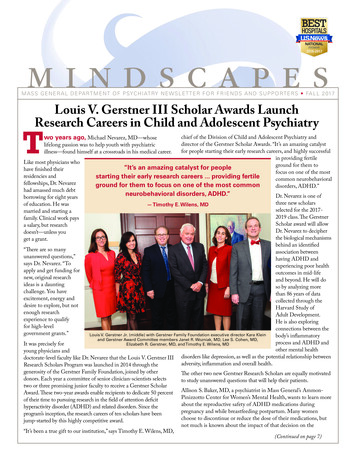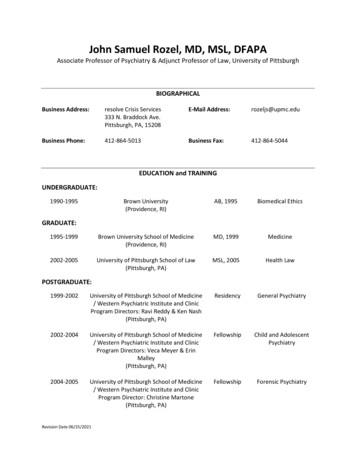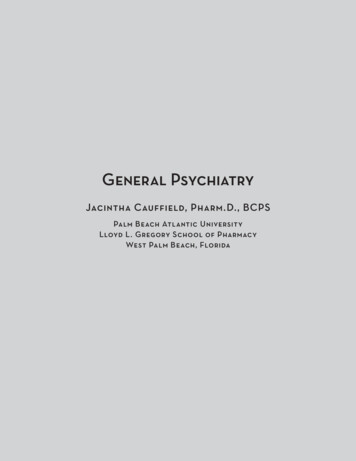
Transcription
General PsychiatryJacintha Cauffield, Pharm.D., BCPSPalm Beach Atlantic UniversityLloyd L. Gregory School of PharmacyWest Palm Beach, Florida
General PsychiatryGeneral PsychiatryJacintha Cauffield, Pharm.D., BCPSPalm Beach Atlantic UniversityLloyd L. Gregory School of PharmacyWest Palm Beach, FloridaACCP Updates in Therapeutics 2015: The Pharmacotherapy Preparatory Review and Recertification Course1-551
General PsychiatryLearning Objectives1. Describe pharmacotherapeutic options for managing major depression, bipolar disorder, schizophrenia, anxiety disorders, insomnia, and substanceabuse.2. Describe the drugs used to treat these disorderswith respect to unique pharmacologic properties,therapeutic uses, adverse effects, and cognitive andbehavioral effects.3. Formulate a pharmacotherapeutic treatment planwhen presented with a patient having major depression, bipolar disorder, schizophrenia, anxiety disorder, insomnia, or substance abuse.Self-Assessment QuestionsAnswers and explanations to these questions can befound at the end of this chapter.1. A.B. is a 25-year-old woman who presents to yourpractice with a depressed mood that has worsenedover the past few weeks. She struggles to get out ofbed in the morning. When she is not sleeping she iseating. She has gained 10 lb in the past month. Sheis worried about her job and does not feel like sheis “pulling her weight,” even though she recentlyreceived a glowing evaluation. She has passivethoughts of harming herself but no definite plan.Her past medical history includes anxiety, gastroesophageal reflux disease, and hypothyroidism.She currently takes levothyroxine 100 mcg daily,lansoprazole 30 mg every morning, and alprazolam 0.5 mg three times daily for anxiety. Whichmedication would best treat her symptoms?improvement on citalopram. She wants to switchantidepressants. Which would be most beneficial?A. Bupropion.B. Duloxetine.C. Nortriptyline.D. Sertraline.3. L.J. is a 45-year-old man who presents agitated andsweating. His right eyelid started twitching about1 hour ago, and he cannot get it to stop. He developed cold symptoms 2 days ago and began takingdextromethorphan and pseudoephedrine. His pastmedical history includes depression, hypertension,and hyperlipidemia. He takes paroxetine 40 mg atbedtime, diltiazem XR 240 mg daily, and rosuvastatin 10 mg daily. Which combination of medications is contributing to his current symptoms?A. Cetirizine and paroxetine.B. Dextromethorphan and pseudoephedrine.C. Diltiazem and pseudoephedrine.D. Paroxetine and dextromethorphan.4. H.G. is a 31-year-old man with a 5-year history ofbipolar disorder type I, for which he takes lithium300 mg twice daily. His serum concentration, takenyesterday before his morning dose of lithium, is1.0 mEq/L. He has been without manic symptomsfor the past few years. He was admitted for a suicide gesture using acetaminophen. Over the pastfew weeks, he has lost interest in his job and isisolating himself from other people. Which medication would best help his acute symptoms?A. Aripiprazole.A. Desipramine.B. Lamotrigine.B. Fluoxetine.C. Quetiapine.C. Mirtazapine.D. Venlafaxine.D. Paroxetine.2. K.M. is a 56-year-old woman with recurrent majordepression, diabetes type 2 with newly diagnosedneuropathy, obesity, and coronary artery disease.She is currently taking citalopram 40 mg daily,carvedilol 25 mg twice daily, lisinopril 40 mgdaily, and metformin 1000 mg twice daily. Sheis tearful during her appointment and continuesto have symptoms of depression despite initial5. H.K. is a 28-year-old woman with a history of bipolar type I. She takes lithium 450 mg twice daily.Her last serum concentration (3 months ago) was0.7 mEq/L. She presents today for an annual examination. Her laboratory test results include sodium138 mEq/L, potassium 4.7 mEq/L, serum creatinine concentration 0.9 mg/dL, glucose 124 mg/dL,and thyroid-stimulating hormone 24 U/mL. She is61 inches tall, and she weighs 165 lb, 15 of whichACCP Updates in Therapeutics 2015: The Pharmacotherapy Preparatory Review and Recertification Course1-552
General Psychiatryshe has gained in the past 2 months. Additionalmedications include olanzapine 10 mg at bedtime,Yasmin daily, and a multivitamin. Which of thefollowing accounts for these findings?A. Hypothyroidism.B. Lithium concentration.C. Olanzapine.D. Yasmin.6. I.T. is a 43-year-old woman with rapidcycling bipolar disorder, hypertension, obesity, and asthma. She recently switched fromlithium to divalproex sodium 500 mg daily.She additionally takes lamotrigine 150 mgtwice daily, aripiprazole 30 mg daily, ramipril10 mg daily, albuterol HFA 2 puffs every6 hours, and Advair 250/50 twice daily, Shestarted a prednisone taper 3 days ago for anasthma exacerbation. Today she presents withabdominal pain with rebound tenderness, nausea, and vomiting. Laboratory test results includesodium 141 mEq/L, potassium 3.3 mEq/L,chloride 95 mEq/L, carbon dioxide 26 mmol/L,serum creatinine concentration 1.0 mg/dL, glucose72 mg/dL, cholesterol 165 mg/dL, triglycerides 188mg/dL, aspartate aminotransferase (AST) 27 IU/L,alanine aminotransferase (ALT) 21 IU/L, amylase456 U/L, and lipase 387 U/L. Which medication isresponsible for the current clinical picture?A. Aripiprazole.B. Divalproex sodium.C. Lamotrigine.D. Prednisone.7. N.B. is a 36-year-old man with 16-year history ofschizophrenia. He was recently switched to aripiprazole from haloperidol because of gynecomastiaand impotence. Today he is pacing your office. Heseems anxious and agitated. He has not been sleeping well and feels uncomfortable in his skin. Whichmedication would help relieve his symptoms?A. Benztropine.B. Dantrolene.C. Lorazepam.D. Propranolol.8. T.Y. is a 64-year-old woman with a 25-year historyof schizophrenia. Over the past year she has developed involuntary chewing motions and abnormalblinking. It has begun interfering with her abilityto eat. She is currently taking haloperidol 2.5 mgtwice daily. Her symptoms improved when her haloperidol dose was decreased from 5 mg twice dailybut have not resolved. She wants to switch antipsychotics. Which would offer the most relief from hersymptoms?A. Chlorpromazine.B. Clozapine.C. Quetiapine.D. Risperidone.9. U.M. is a 38-year-old woman with a 4-year historyof schizophrenia. Within the past year she has beendiagnosed with diabetes type 2 and dyslipidemia.Her body mass index is 32 kg/m2. Her father diedof a myocardial infarction (MI) at age 42. She hasbeen treated with risperidone but has developedgalactorrhea. Concomitant medications includeatorvastatin, metformin, and liraglutide. Whichantipsychotic would be the best choice?A. Olanzapine.B. Paliperidone.C. Quetiapine.D. Ziprasidone.10. N.Y. is a 20-year-old woman who presents to theemergency department after experiencing trembling, sweating, chest pain, and shortness of breathaccompanied by intense fear. An MI has been ruledout. Which medication regimen would effectivelytreat her acute symptoms?A. Alprazolam.B. Buspirone.C. Hydroxyzine.D. Paroxetine.11. T.R. is a 55-year-old woman with generalized anxiety disorder. Concomitant medical conditionsinclude history of breast cancer, dyslipidemia,osteoarthritis, menopausal symptoms, and osteopenia. She takes tamoxifen, simvastatin, ibuprofen,lorazepam, and alendronate. Her physician wouldACCP Updates in Therapeutics 2015: The Pharmacotherapy Preparatory Review and Recertification Course1-553
General Psychiatrylike her to have better control of her anxiety symptoms. He would also like to taper her off lorazepam. Which agent would be the best choice?A. Bupropion.B. Fluoxetine.albumin 4.0 g/dL, alkaline phosphatase 75 IU/L,total bilirubin 0.3 mg/dL, prothrombin time 0.9seconds, platelet count 370 x 103 cells/mm3, andcreatinine clearance 40 mL/min. After detoxification, which maintenance treatment is appropriate?A. Acamprosate 666 mg three times daily.C. Pregabalin.B. Chlordiazepoxide 25 mg four times daily.D. Venlafaxine.C. Disulfiram 500 mg daily.12. O.P. is a 74-year-old woman who has difficulty getting to sleep. Once she falls asleep she rests comfortably throughout the night. She struggles withkeeping a bedtime. This problem has been ongoingfor the past few months. She has no contributingfactors. Concomitant medical conditions includehypertension, arthritis, and mild cognitive impairment. She has tried diphenhydramine. She statesit helped for only a few nights and “it made meloopy.” She would like a medication with the leastrisk of hangover effect. Which medication is best?A. Eszopiclone.B. Ramelteon.C. Suvorexant.D. Naltrexone 50 mg daily.15. J.Z. is a 44-year-old man who is getting ready tobe discharged from the hospital after an MI. Hehas a 25-pack-year history of smoking cigarettesand smokes 1-1/2 packs per day. He has tried twiceunsuccessfully to quit. His additional past medical history includes recurrent depression. He triedquitting cold turkey the first time about 5 years ago.He resumed smoking 6 months later when he losthis job. He tried again approximately 6 months agousing nicotine gum. He used the 2-mg strength. Tosave money, he chewed 7 pieces daily. Which regimen would be best?A. Bupropion.D. Zolpidem.B. Nicotine 4 mg gum.13. M.K. is a 23-year-old man with a history of heroinaddiction. He has been successfully maintained onmethadone 40 mg daily for 1 year. He would likean option that does not require him to go to a dailyopioid treatment program to get his methadonedose. He is not taking other medication, nor doeshe abuse other substances. Which treatment regimen is appropriate?C. Nicotine patch 21 mg/day.D. Varenicline.A. Initiate supervised buprenorphine/naloxone.B. Switch to buprenorphine x 2 days, thenbuprenorphine/naloxone.C. Switch to naltrexone.D. Taper to methadone 30 mg, then switch tobuprenorphine.14. C.H. is a 55-year-old man with a 30-year historyof alcohol dependence. He drinks 1 pint of vodkadaily. He has tried numerous times to quit without success. He has recently reconciled with hisestranged son and wants to be sober so that he canbe more present in his son’s life. His liver functiontest results include AST 143 IU/L, ALT 74 IU/L,ACCP Updates in Therapeutics 2015: The Pharmacotherapy Preparatory Review and Recertification Course1-554
General PsychiatryPatient CasesQuestions 1–4 pertain to the following case:A.Z. is a 45-year-old woman with sleep apnea, hypertension, type 2 diabetes mellitus, and chronic pain. Sheis being seen in the clinic today for an assessment of her depressive symptoms and medication evaluation. Sheendorses sad mood, poor appetite (lost 15 lb), poor concentration, and feelings of hopelessness and worthlessness for the past 3 weeks. She has also stopped going to her book club because she is not motivated to get out ofthe house, and she has frequent nocturnal awakening. She denies suicidal or homicidal ideation. She denies anyuse of alcohol, tobacco, or illicit drugs. She is currently taking hydrochlorothiazide, metformin, hydrocodone/acetaminophen, and aspirin. You decide that A.Z. should receive an antidepressant in the selective serotoninreuptake inhibitor (SSRI) class to treat her depressive symptoms.1. Which SSRI would be most likely to interact with her current medications?A. Citalopram.B. Fluvoxamine.C. Paroxetine.D. Sertraline.2. Which antidepressant would be most appropriate for A.Z.’s depressive symptoms?A. Bupropion.B. Fluoxetine.C. Mirtazapine.D. Venlafaxine.3. It has been 4 weeks since A.Z.’s initial visit with you, and she has been treated with citalopram 20 mg/day inthe morning. She still presents with sad mood, but her insomnia, concentration, and appetite have improved.She still has feelings of hopelessness and worthlessness, lack of motivation, and anhedonia. At this point,which is the best recommendation to optimize her therapy?A. Continue at current dose of 20 mg/day.B. Increase the current dose to 40 mg/day.C. Add bupropion 150 mg twice daily.D. Switch to a different SSRI.4. Six months later, A.Z. reports that although her depression symptoms have resolved, she has “trouble” duringintercourse, which is quite disturbing to her. You determine that she has anorgasmia caused by citalopramtreatment. Which is the most appropriate recommendation at this time?A. Discontinue citalopram.B. Add bupropion to treat anorgasmia.C. Switch to a different SSRI.D. Switch to mirtazapine.ACCP Updates in Therapeutics 2015: The Pharmacotherapy Preparatory Review and Recertification Course1-555
General PsychiatryI.DEPRESSIONA. Identification of Depressive Disorders. This overview is based on the Diagnostic and Statistical Manual forMental Disorders (DSM-5); please consult the DSM-5 for complete diagnostic criteria.1. Major depressive disorder (MDD), otherwise called unipolar disorder. It is diagnosed when a patientexhibits at least 5 of the following symptoms nearly every day for at least 2 weeks:a. The patient must have a depressed mood or anhedonia (loss of interest in pleasurable activities).b. Additional symptoms include sleep disturbances, changes in weight or appetite, decreased energy,feelings of guilt or worthlessness, psychomotor retardation or agitation, decreased concentration,and suicidal ideation.c. The symptoms must interfere with the patient’s everyday ability to function.2. Persistent depressive disorder (dysthymia): Chronic depressed mood occurring more days than not forat least 2 years but does not meet the criteria for MDDB. Assessment of Patients With MDD1. Psychiatric history: A thorough history of symptoms is compared with the diagnostic criteria, and thediagnosis is made from the collected data.2. Clinician rating scales: These are psychometric instruments used to identify depression and assessits severity. Common examples are the Hamilton Rating Scale for Depression (HAM-D) and theQuick Inventory of Depressive Symptoms Clinician Rated. A response is usually defined as at leasta 50% reduction in the HAM-D score. “Remission” is a return to a normal state or a HAM-D of7 or less. Scores from these scales are not required for the diagnosis, but the HAM-D is a standardinstrument used to show efficacy in clinical trials for U.S. Food and Drug Administration (FDA)approval. The Clinical Global Impression scale is a clinician-rated scale that evaluates the severityand improvement of patients overall. The Montgomery-Åsberg Depression Rating Scale is anotherinstrument that evaluates symptoms of depression. The Patient Health Questionnaire–9 is based onthe DSM-5 diagnostic criteria for major depression. It is easily administered and assessed and is thusfrequently used in the primary care setting.3. Patient rating scales: These are patient-completed rating instruments. Answers to the questions are usedto identify and assess the level of depression. The Beck Depression Inventory and the Quick Inventoryof Depressive Symptoms Self-Rated are examples.4. Physical examination and laboratory tests: These are necessary to rule out physical causes (e.g., thyroiddisorders, vitamin deficiencies) that may mimic symptoms of depression.5. Biologic testing: Depression is commonly associated with abnormalities in the dexamethasone suppression test and tests of the thyroid axis. However, these tests are not routinely used in clinical practice.6. Medications and substances (e.g., interferons, benzodiazepines, barbiturates, alcohol, central nervoussystem depressants, lipid-soluble β-blockers, withdrawal from stimulants, cocaine, amphetamines) canhave depression as an adverse effect. Pharmacists should perform a medication and substance usereview to identify possible causes.C. Therapeutic Options1. Psychotherapy and exercise: Examples include interpersonal psychotherapy and cognitive-behavioraltherapy (CBT). With psychotherapy, it takes longer to observe effectiveness, but when combined withpharmacotherapy, it is effective. It may have broader and longer-lasting effects. Psychotherapy is recommended as monotherapy as initial treatment in patients with mild to moderate MDD (CBT andinterpersonal therapy have the best evidence).2. Pharmacotherapy: Medication therapy may lead to a more rapid response than psychotherapy, but whenit is discontinued, there is a risk of relapse and adverse effects.ACCP Updates in Therapeutics 2015: The Pharmacotherapy Preparatory Review and Recertification Course1-556
General Psychiatry3. Electroconvulsive therapy (ECT): Option for refractory depression, depression in pregnancy, psychoticdepression, and other conditions for which medications may not be optimal or effective. The usualcycle is two or three treatments per week. Temporary memory loss is common, and medications thataffect seizure threshold must be withdrawn before treatment. Electroconvulsive therapy has also beenrecently suggested as initial treatment if symptoms are severe or life threatening (American PsychiatricAssociation [APA] 2010 guidelines).D. Pharmacotherapeutic Options: Considerations and Keys to Use1. Selection: All antidepressants are considered to be equally efficacious. First-line medications includeselective serotonin reuptake inhibitors (SSRIs), serotonin norepinephrine reuptake inhibitors (SNRIs),bupropion, and mirtazapine. Consider possible drug-drug and drug-disease interactions, concurrentillnesses, prior responses, family members’ prior responses, patient preference, and cost.2. Onset: In general, it takes 4–6 weeks to see the full effect of antidepressants, given the correct drug,dose, and adherence, but it may take as long as 8 weeks to see a response. Remission may take up to12 weeks. Some symptoms (e.g., sleep disturbances) may show improvement in 1–2 weeks.3. Adequate trial: An adequate trial includes the correct drug for the patient and a therapeutic dose for anappropriate duration. A therapeutic trial ranges from 4 to 8 weeks (2010 APA practice guideline).4. Response and remission: A response is usually defined as a 50% reduction in symptoms. Remission isa return to normal mood (e.g., HAM-D of 7 or less). Optimizing the dose or duration is important forachieving remission.5. Efficacy of antidepressants according to rigorous clinical trials is about 60%–70%, regardless of drug.Effectiveness, which is more reflective of clinical practice, is lower, about 50%–60%. The remissionrate with one antidepressant is about 30%, seen in the recent Sequenced Treatment Alternatives toRelieve Depression (STAR*D trial), when the first drug is initiated.6. Drug interactions (Table 1): Many antidepressants inhibit cytochrome P450 (CYP) enzymes.Table 1. Antidepressants and the CYP SystemCYP Enzyme1A22C2D63A4Minimal CYP inhibitionInhibition PotentialFluvoxamine: highFluoxetine: moderateFluoxetine, fluvoxamine, sertraline: lowFluoxetine, paroxetine: very highDuloxetine: moderateBupropion, citalopram, escitalopram, sertraline: very lowNefazodone: very highFluvoxamine: moderateFluoxetine: lowSertraline: very lowVenlafaxine, desvenlafaxine, mirtazapine, levomilnacipranCYP cytochrome P450.E. Tricyclic Antidepressants1. Tricyclic antidepressants (TCAs) were the first antidepressants available. They are seldom used fordepression, but they have several off-label uses such as treatment for pain syndromes, migraine prophylaxis, and anxiety disorders. They are effective, but adverse effects have limited their use. Now thatnewer agents with more tolerable adverse effect profiles are available, these agents are used less often.ACCP Updates in Therapeutics 2015: The Pharmacotherapy Preparatory Review and Recertification Course1-557
General Psychiatry2. They block the reuptake of serotonin and norepinephrine (NE). The tertiary amines are more potent forNE uptake and are metabolized to active secondary amines.3. In addition to serotonin and NE reuptake, TCAs have α-adrenergic blockade, antihistaminic effects,and anticholinergic effects, leading to orthostasis, sedation, and anticholinergic symptoms, respectively. They also have cardiotoxic effects (Table 2).4. TCAs can be fatal in overdose. They cause seizures and torsades de pointes. An actively suicidal patientshould not receive a TCA.Table 2. Adverse Effect Profile of the Commonly Used Tricyclic AntidepressantsDrugTertiary aminesAmitriptylineImipramineSecondary ationOrthostatic owModerateModerate5. These drugs must be used cautiously in patients with cardiac disease or seizure disorders. Patients atrisk of orthostatic hypotension are at elevated risk of falls if they take these agents, and appropriatecaution should be taken.6. One advantage of TCAs is that therapeutic serum concentrations can be measured. Therapeutic levelscan be used to confirm adherence or toxicity. In clinical practice, this is an infrequent practice.7. A withdrawal syndrome occurs if these drugs are discontinued too quickly. Symptoms reflect the reversal of anticholinergic effects and include lacrimation, nausea, and diarrhea, with insomnia, restlessness,and possible balance problems. Gradual dose reductions help reduce these symptoms.Monoamine Oxidase Inhibitors1. Monoamine oxidase inhibitors (MAOIs) block the enzyme responsible for the breakdown of certainneurotransmitters, such as NE. There are two forms of this enzyme (MAO-A and MAO-B), and drugscan block one or both of them. They are effective antidepressants and may be especially useful foratypical depression (hypersomnia, hyperphagia, and mood reactivity).2. Nonselective drugs (phenelzine and tranylcypromine) are available in the United States.3. Patients taking MAOIs must be educated and monitored to avoid foods high in tyramine (e.g., agedcheese, preserved meats) because of the potential for precipitating a hypertensive crisis. A dietaryconsultation can be helpful in this respect.4. Drug interactions with MAOIs are considerable and include over-the-counter decongestants, antidepressants, stimulants, antihypertensives, and others. When switching a patient from another antidepressant to an MAOI, it is prudent to wait 2 weeks after the antidepressant is discontinued before initiatingthe MAOI (except for fluoxetine, in which case the waiting period should be 5–6 weeks). When a patientis changed from an MAOI to another antidepressant, a 2-week washout period is usually adequate.5. Selegiline (MAO-B inhibitor) is available in a patch formulation called Emsam for the treatment ofdepression. It is available in doses of 6 mg/24 hours, 9 mg/24 hours, and 12 mg/24 hours. Once the dosereaches 9 mg/24 hours, an MAOI diet is required. How this drug compares with other antidepressantsremains unknown.ACCP Updates in Therapeutics 2015: The Pharmacotherapy Preparatory Review and Recertification Course1-558
General PsychiatryG. Selective Serotonin Reuptake Inhibitors (SSRIs)1. SSRIs selectively inhibit the reuptake of serotonin into the presynaptic neuron. There has been speculation that they also desensitize the presynaptic serotonin autoreceptor involved in the negative feedbackloop that normally inhibits serotonin release. Whichever is true, the result is increased serotonin concentrations in the synapse. The FDA has approved six SSRIs for the treatment of depression: fluoxetine,sertraline, paroxetine, fluvoxamine, citalopram, and escitalopram. Fluvoxamine is indicated only forobsessive-compulsive disorder (OCD) but is an effective antidepressant.Table 3. Characteristics of SSRIsCharacteristicHalf-lifeActivemetaboliteUsual dose (mg/day)Maximal dailydose (mg)Fluoxetine1–4 daysYesbSertraline26 hoursNoParoxetine21 hoursNoFluvoxaminea15 hoursNoCitalopram32 hoursNoEscitalopram27–32 08020050(depression)60 (anxiety)3004020Indicated only for obsessive-compulsive disorder; seldom used for depression.Norfluoxetine.SSRI selective serotonin reuptake inhibitor.ab2. The efficacy of SSRIs is equal for treatment of depression. There are slight differences in adverse effectprofiles, and patients may tolerate one better than another. The STAR*D trial showed that patients whodo not respond to one SSRI may respond to another.3. Blockade of serotonin reuptake leads to an increase in serotonin overall and may influence all subtypesof serotonin receptors. Some of these (serotonin-2A, serotonin-2C, serotonin-3, and serotonin-4) maybe responsible for some of the unwanted adverse effects (e.g., insomnia, restlessness, gastrointestinal [GI] complaints). Activation, agitation, anxiety, or panic may be seen in some patients, especiallyduring the early phase of therapy. The most common adverse effects associated with this class of agentsinclude GI complaints, insomnia, restlessness, headache, and sexual dysfunction. In general, the mostactivating SSRIs are fluoxetine, sertraline, and vilazodone, whereas paroxetine and fluvoxamine are themost sedating. Vortioxetine, citalopram, and escitalopram do not have appreciable sedating or activating effects. Sexual dysfunction is more common than reported in the prescribing information. Someinterventions to consider for SSRI-induced sexual dysfunction include using the wait-and-see method,adding bupropion for the treatment of sexual dysfunction, lowering the dose of the SSRI, or adding anagent such as sildenafil or cyproheptadine. Of course, changing to a drug less likely to cause this problem is also reasonable.4. Because these drugs have such potent serotonergic activity, combinations with other drugs affectingserotonin can lead to serotonin syndrome. Examples include MAOIs, dextromethorphan, meperidine,sympathomimetics, triptans, lithium, TCAs, and SNRIs. Serotonin syndrome includes symptoms fromthree clusters: neuromuscular hyperactivity (e.g. myoclonus, rigidity, tremors, incoordination), alteredmental status (agitation, confusion, hypomania), and autonomic instability (hyperthermia, diaphoresis).It can be subtle in onset or be confused with neuroleptic malignant syndrome. Treatment includes discontinuing the offending agent, providing supportive measures such as cooling blankets and respiratoryassistance, and providing clonazepam for myoclonus, anticonvulsants for seizures, and nifedipine forhypertension.ACCP Updates in Therapeutics 2015: The Pharmacotherapy Preparatory Review and Recertification Course1-559
General Psychiatry5. SSRIs have been associated with extrapyramidal symptoms (EPS), including akathisia, dystonia, andbradykinesia, but these are not common. This appears to result from an effect of serotonin on dopaminergic neurotransmission in the basal ganglia.6. A withdrawal syndrome has been observed, especially for the drugs with shorter half-lives, so a gradual dose reduction (e.g., over 2–4 weeks) may be indicated. Symptoms include flulike symptoms, suchas nausea and chills, and neurologic symptoms, such as paresthesias, insomnia, anxiety, and “electricshock”-type sensations. If the problem is severe or persists, the drug can be reinitiated and the dosegradually reduced again. It is most common with paroxetine, less so with sertraline, and even less likelywith fluoxetine.7. In 2001, the FDA ordered changes to citalopram package labeling limiting the daily dose to a maximumof 40 mg because of an elevated risk of QTc prolongation at daily doses greater than 40 mg. Patientswho have risk factors for QTc prolongation (congenital long QTc syndrome, bradycardia, hypokalemia, hypomagnesemia, recent acute myocardial infarction, and uncompensated heart failure) or haveconcomitant medications that may increase QTc interval should not be treated with citalopram. Dosesof citalopram should be lowered to 40 mg/day in patients who are receiving higher dosages unless thebenefits significantly outweigh the risks. The maximal recommended dose of citalopram is 20 mg/dayfor patients with hepatic impairment, patients who are older than 60 years, patients who are CYP2C19poor metabolizers, or patients who are taking concomitant cimetidine or another CYP2C19 inhibitor.8. These drugs are not as lethal in cases of overdose as are TCAs. All SSRIs are available in generic formexcept for vilazodone and vortioxetine. The low cost and better tolerability of SSRIs warrant them asfirst-line treatment of MDD in most patients.9. Extended dosing formulations: Fluoxetine 90 mg can be taken once weekly. It is taken only duringcontinuation therapy rather than as initial treatment. Paroxetine controlled release may have lower ratesof nausea in the first week of treatment; efficacy is comparable, and both formulations are administeredonce daily. The weekly and controlled release (CR) products are available generic but are higher in cost.10. Escitalopram is the S-isomer of citalopram. It is the active component of the racemic mixture. At a10-mg dose, it is as effective as citalopram 20 mg (or 40 mg as described in prescribing information),but at this dose, there are fewer adverse effects. At higher doses, this advantage is not as pronounced.11. SSRIs appear to increase the risk of bleeding. Several mechanisms have been proposed, including theinhibition of serotonin activation of platelets. Case-control and cohort studies also suggest an elevatedincidence of both vertebral and nonvertebral bone fractures.H. Serotonin Norepinephrine Reuptake Inhibitors (SNRIs)1. Venlafaxine, desvenlafaxine, duloxetine, and levomilnacipran block the reuptake of NE and serotonin.Unlike TCAs, they have negligible effects at other receptors that cause anticholinergic or antihistaminic adverse effects, with the possible exception of duloxetine, which appears to have a slightly higherincidence of anticholinergic symptoms. Venlafaxine has a dose-related effect on NE compared withdesvenlafaxine and duloxetine. At doses less than 150 mg/day, venlafaxine has primarily a serotonineffect.2. Levomilnacipran is a newly approved SNRI. It is the enantiomer of milnacipran, the latter of which i
General Psychiatry Jacintha Cauffield, Pharm.D., BCPS Palm Beach Atlantic University Lloyd L. Gregory School of Pharmacy West Palm Beach, Florida. . Her body mass index is 32 kg/m2. Her father died of a myocardial infarction (MI) at age 42. She has been treated with risperidone but has developed
